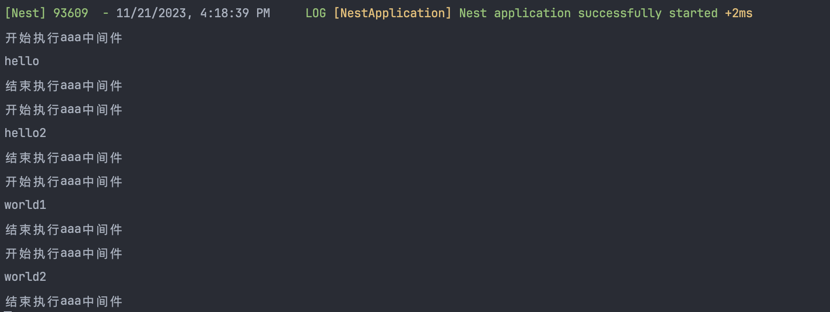
自定义中间件
在前面的文章中简单介绍了一下中间件是什么,并简单使用了下中间件,这里就看下如何自定义一个中间件以及需要注意的地方。
先用 cli 新建一个中间件文件
shell
nest g middleware aaa --no-spec --flat执行这个命令会生成一个中间件文件aaa.middleware.ts
ts
import { Injectable, NestMiddleware } from '@nestjs/common'
@Injectable()
export class AaaMiddleware implements NestMiddleware {
use(req: any, res: any, next: () => void) {
next()
}
}因为不知道你的底层框架使用的是 express 还是 fastify,所以这里的参数类型是 any,你可以根据你使用的框架手动去改。一般来说使用的都是 express。
ts
import { Injectable, NestMiddleware } from '@nestjs/common'
import { Request, Response } from 'express'
@Injectable()
export class AaaMiddleware implements NestMiddleware {
use(req: Request, res: Response, next: () => void) {
next()
}
}中间件中使用了@Injectable装饰器,由此看出中间件也类似提供一个服务的提供者。可以在 next()方法的前后加一些处理逻辑,这个会在中间件的开始和结束时候触发。next 方法会把控制权交给下一个中间件。
ts
import { Injectable, NestMiddleware } from '@nestjs/common'
import { Request, Response } from 'express'
@Injectable()
export class AaaMiddleware implements NestMiddleware {
use(req: Request, res: Response, next: () => void) {
console.log('brefore')
next()
console.log('after')
}
}使用中间件
上面简单定义了一个中间件, 接下来我们在app.module.ts中使用它。
ts
import { MiddlewareConsumer, Module, NestModule } from '@nestjs/common'
import { AppController } from './app.controller'
import { AppService } from './app.service'
import { AaaMiddleware } from './aaa.middleware'
@Module({
imports: [],
controllers: [AppController],
providers: [AppService]
})
export class AppModule implements NestModule {
configure(consumer: MiddlewareConsumer) {
consumer.apply(AaaMiddleware).forRoutes('*')
}
}启动项目看下执行效果

这里是对所有路由启用,你也可以指定精确一点的路由。先定义几个路由作为区分
ts
import { Controller, Get } from '@nestjs/common'
import { AppService } from './app.service'
@Controller()
export class AppController {
constructor(private readonly appService: AppService) {}
@Get('hello')
getHello(): string {
console.log('hello')
return this.appService.getHello()
}
@Get('hello2')
getHello2(): string {
console.log('hello2')
return this.appService.getHello()
}
@Get('world1')
getWorld1(): string {
console.log('world1')
return this.appService.getHello()
}
@Get('world2')
getWorld2(): string {
console.log('world2')
return this.appService.getHello()
}
}在 app.module.ts 中指定路由
ts
import { MiddlewareConsumer, Module, NestModule } from '@nestjs/common'
import { AppController } from './app.controller'
import { AppService } from './app.service'
import { AaaMiddleware } from './aaa.middleware'
@Module({
imports: [],
controllers: [AppController],
providers: [AppService]
})
export class AppModule implements NestModule {
configure(consumer: MiddlewareConsumer) {
consumer.apply(AaaMiddleware).forRoutes({
path: 'hello*',
method: RequestMethod.GET
})
consumer.apply(AaaMiddleware).forRoutes({
path: 'world*',
method: RequestMethod.GET
})
}
}浏览器访问对应的路由,看下执行结果。

这是中间件的简单使用,但是这样的使用方式和 express 差不多,但是 nest 中装饰器可以是类 class,因为如果是类的话,就可以使用依赖注入来注入服务进行一些逻辑使用。
ts
import { AppService } from './app.service'
import { Inject, Injectable, NestMiddleware } from '@nestjs/common'
import { Request, Response } from 'express'
@Injectable()
export class AaaMiddleware implements NestMiddleware {
@Inject(AppService)
private readonly appService: AppService
use(req: Request, res: Response, next: () => void) {
console.log('brefore')
console.log('-------' + this.appService.getHello())
next()
console.log('after')
}
}这里也可以使用构造函数注入,前面有提到过,这里的提供者注入有很多方式,忘记的可以去看看
ts
import { AppService } from './app.service'
import { Inject, Injectable, NestMiddleware } from '@nestjs/common'
import { Request, Response } from 'express'
@Injectable()
export class AaaMiddleware implements NestMiddleware {
constructor(private readonly appService: AppService) {}
use(req: Request, res: Response, next: () => void) {
console.log('brefore')
console.log('-------' + this.appService.getHello())
next()
console.log('after')
}
}访问下路由看下控制台输出

如果全局使用中间件可以使用app.use()方法,这个就和 express 差不多了。
中间件和拦截器
从表现上看,感觉中间件和拦截器的处理时机是差不多的。但是它俩还有一些细微的区别的。interceptor 是能从 ExecutionContext 里拿到目标 class 和 handler,进而通过 reflector 拿到它的 metadata 等信息的,这些 middleware 就不可以。
再就是 interceptor 里是可以用 rxjs 的操作符来组织响应处理流程的。middleware 里也不可以。
它们都是 Nest AOP 思想的实现,但是 interceptor 更适合处理与具体业务相关的逻辑,而 middleware 适合更通用的处理逻辑。
总结
本文简单实现了自定义中间件的编写和使用,当然在业务中不会有这么简单的中间件。而且也对比了和拦截器的区别,希望对你有帮助。

